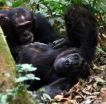(Press-News.org) Forget digital fingerprints, iris recognition and voice identification, the next big thing in biometrics could be your knobbly knees. Just as a fingerprints and other body parts are unique to us as individuals and so can be used to prove who we are, so too are our kneecaps. Computer scientist Lior Shamir of Lawrence Technological University in Southfield, Michigan, has now demonstrated how a knee scan could be used to single us out.
The approach based on MRI could be used to quickly register and identify people in a moving queue as they approach passport control at airports for instance or as they walk through the entrance to an office block or other building.
Shamir has tested the approach and achieved accuracy of around 93 percent, this coupled with other factors such as possession of the correct passport, being in the right place at the right time or tied to other biometrics such as iris recognition and signature analysis could be used to prevent deception and fraud. Contact lenses can be used to dupe iris recognition systems, passports can be forged.
"Deceptive manipulation requires an invasive and complicated medical procedure, and therefore it is more resistant to spoofing compared to methods such as face, fingerprints, or iris," Shamir points out. It would be almost impossible to fake one's internal body parts including the kneecaps. Of course, kneecaps are a renowned target of irreversible and deleterious adjustment in the criminal world, but even then shattered kneecaps are likely to be unique to the victim in any case.
MRI scanning avoids health risk of scanning with ionizing radiation, such as X-rays, it would also avoid some of the privacy issues that have arisen with terahertz scanners that can "see" beneath a person's clothing, whereas MRI goes more than skin deep. There is a distinct problem with the implementation of MRI scanning in a security setting in that MRI scanners are very large machines and take a long time to acquire an image of even a small body part such as the kneecap. However, developments in MRI technology are fast moving and it is likely that within the medium term more portable and faster equipment will emerge that could fulfill the security role.
"Further studies will develop the concept of internal biometrics, and will lead to automatic identification methods that are highly resistant to spoofing," concludes Shamir.
### "MRI-based knee image for personal identification" in Int. J. Biometrics, 2013, 5, 113-125
Knobbly knees in competition with fingerprints
Biometrics using internal body parts
2013-01-23
ELSE PRESS RELEASES FROM THIS DATE:
Women must do more to reap same positive health outcomes as men, MU research suggests
2013-01-23
COLUMBIA, Mo. — More than one-third of Americans are obese, and these individuals often experience accompanying health issues, such as Type 2 diabetes and cardiovascular problems. In response to the so-called "obesity epidemic," many medical professionals have suggested ways to improve the health outcomes of obese individuals through diet and exercise. Now, research conducted at the University of Missouri suggests certain exercises that benefit obese men may not have the same positive results for obese women. These findings could help health providers and researchers develop ...
Study shows high blood calcium levels may indicate ovarian cancer
2013-01-23
WINSTON-SALEM, N.C. – Jan. 23, 2013 – A new study from Wake Forest Baptist Medical Center is the first to report that high blood calcium levels might predict of ovarian cancer, the most fatal of the gynecologic cancers.
Lead author Gary G. Schwartz, Ph.D., a cancer epidemiologist at Wake Forest Baptist, and colleague, Halcyon G. Skinner, Ph.D., of the University of Wisconsin Carbone Cancer Center, examined associations between blood calcium and ovarian cancer in two national population-based groups. They found that women who were later diagnosed with ovarian cancer and ...
Social Scientists call for more effective teaching in Higher Education
2013-01-23
A new position paper, The Professionalisation of Academics as Teachers in Higher Education, has been published today by the European Science Foundation.
In Europe, where over 19 million students are in tertiary education, it is becoming crucial to look at, study and improve the teaching skills of scientists in order to teach more effectively the next generation of innovators. This is not only of interest to the Social Sciences but an issue of basic importance to all domains of science and to society as a whole.
The publication exposes current developments and challenges ...
Free clinics reduce emergency department visits
2013-01-23
HERSHEY, Pa. -- People who receive primary care from free clinics are less likely to use the emergency department for minor issues, according to a team of medical researchers.
Nationally, the number of emergency departments (EDs) has decreased yet the number of ED visits has gone up, the team reported. Therefore, it is important to figure out how to reduce unnecessary ED visits.
According to the National Association of Free and Charitable Clinics, there are more than 1,200 free clinics nationwide. Many of these clinics work in cooperation with one of their local hospitals.
Wenke ...
The benefits of social grooming
2013-01-23
This press release is available in German.
Animals which maintain cooperative relationships show gains in longevity and offspring survival. However, little is known about the cognitive or hormonal mechanisms involved in cooperation. Researchers of the Max Planck Institute for Evolutionary Anthropology in Leipzig, Germany, have now found that cooperative relationships are facilitated by an endocrinological mechanism involving the hormone oxytocin, even when these are between non-kin. They collected urine samples of 33 chimpanzees from Budongo Forest, Uganda, and ...
Climate change could cause massive losses in Pyrenees ski resorts
2013-01-23
An increase in temperatures due to climate change could mean that the Andorran ski resorts have a shorter season in the future, especially in lower areas. A study undertaken by the Polytechnic University of Catalonia and the Andorran Sustainability Observatory has analysed the specific case of the Pyrenean country and predicted that financial losses could come close to 50 million euros.
SINC. 22 de enero de 2013
One of the major challenges when studying climate change effects is to establish the relationship between physical impacts and environmental changes on the ...
The global gene pool of the goat is seriously under threat
2013-01-23
Amongst the range of domestic livestock species, the goat is not just the 'black sheep' but a resource of survival in impoverished countries, and many breeds are at great risk of disappearing. This is the case according to researchers of the Regional Service of Agro-Food Research and Development in their first monographic study tackling the global impact of this species.
A study from the Regional Service of Agro-Food Research and Development (SERIDA) has analysed the situation of the global goat population.
The study took into account the state of different breeds, ...
How the purple and pink sunscreens of reef corals work
2013-01-23
New research by the University of Southampton has found a mechanism as to how corals use their pink and purple hues as sunscreen to protect them against harmful sunlight.
Many reef corals need light to survive, as they benefit from sugars and lipids that are produced by their light-dependent symbiotic algae. However, in the shallow water of coral reefs, light levels are often higher than required by the corals, so paradoxically, the vital sunlight can become harmful for the algae and their hosts.
Apart from temperature, light stress is a major driver of coral bleaching ...
Santiago, Chile, will get drier and warmer
2013-01-23
This press release is available in German and Spanish.
Santiago de Chile/Leipzig. Already nowadays ten per cent or more of the population in the Metropolitan Region of Santiago de Chile is affected by extreme heat or floods. These threats will tend to increase due to the continuous expansion of the Chilean capital, the consequent changes in land use and the influences of climate change. Because of that, the international research project ClimateAdaptationSantiago (CAS) has developed, during the last three years, an Adaptation Plan to climate change for the metropolitan ...
Breakthrough: How salt stops plant growth
2013-01-23
Washington, D.C. —Until now it has not been clear how salt, a scourge to agriculture, halts the growth of the plant-root system. A team of researchers, led by the Carnegie Institution's José Dinneny and Lina Duan, found that not all types of roots are equally inhibited. They discovered that an inner layer of tissue in the branching roots that anchor the plant is sensitive to salt and activates a stress hormone, which stops root growth. The study, published in the current issue of The Plant Cell, is a boon for understanding the stress response and for developing salt-resistant ...
LAST 30 PRESS RELEASES:
University of Oklahoma researcher awarded funding to pursue AI-powered material design
Exploring how the visual system recovers following injury
Support for parents with infants at pediatric check-ups leads to better reading and math skills in elementary school
Kids’ behavioral health is a growing share of family health costs
Day & night: Cancer disrupts the brain’s natural rhythm
COVID-19 vaccination significantly reduces risk to pregnant women and baby
The role of vaccination in maternal and perinatal outcomes associated with COVID-19 in pregnancy
Mayo Clinic smartwatch system helps parents shorten and defuse children's severe tantrums early
Behavioral health spending spikes to 40% of all children’s health expenditures, nearly doubling in a decade
Digital cognitive behavioral treatment for generalized anxiety disorder
Expenditures for pediatric behavioral health care over time and estimated family financial burden
Air conditioning in nursing homes and mortality during extreme heat
The Alps to lose a record number of glaciers in the next decade
What makes a good proton conductor?
New science reporting guide published for journalists in Bulgaria
New international study reveals major survival gaps among children with cancer
New science reporting guide published for journalists in Turkey
Scientists develop a smarter mRNA therapy that knows which cells to target
Neuroanatomy-informed brain–machine hybrid intelligence for robust acoustic target detection
Eight SwRI hydrogen projects funded by ENERGYWERX
The Lundquist Institute and its start-up company Vitalex Biosciences Announces Strategic Advancement of Second-Generation fungal Vaccine VXV-01 through Phase 1 Trials under $40 Million Competitive Con
Fine particles in pollution are associated with early signs of autoimmune disease
Review article | Towards a Global Ground-Based Earth Observatory (GGBEO): Leveraging existing systems and networks
Penn and UMich create world’s smallest programmable, autonomous robots
Cleveland researchers launch first major study to address ‘hidden performance killer’ in athletes
To connect across politics, try saying what you oppose
Modulating key interaction prevents virus from entering cells
Project explores barriers to NHS career progression facing international medical graduates
Jeonbuk National University researchers explore the impact of different seasonings on the flavor perception of Doenjang soup
Two Keck Medicine of USC Hospitals named Leapfrog Top Teaching Hospitals
[Press-News.org] Knobbly knees in competition with fingerprintsBiometrics using internal body parts




